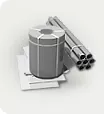China's Belt and Road Initiative (BRI) is one of those rare things that almost everyone seems to have heard of, but equally very few people can claim to understand in detail what it means.
Thinking in a big way, the BRI as a kind of Marshall Plan for Asia, Africa and even Europe is a set of impressive sounding numbers that overshadows the scale of the American initiative that helped rebuild Europe after World War II.
The heart of the BRI is the efficient creation of a huge number of infrastructure and energy projects in at least 70 countries, which are home to 65% of the world's population and about 40% of its production.
A centerpiece of Chinese President Xi Jinping's economic agenda is also the development of the mines and oil and gas fields needed to supply raw materials for this vast venture.
For proponents, the BRI is a means by which less developed countries will increase their growth and push their populations out of poverty.
The answer to the question of whether the project is indeed the beginning of a new supercycle for goods will become clear if Beijing can successfully change the process from a slogan to an agreed multilateral initiative that is yielding real results.
Asian countries need to spend $ 1.7 trillion a year on infrastructure in the coming years, more than double their current investment levels. This was announced in Hong Kong by the chairman of the consulting company Cedrus Group Rani Yarkas.
It is these numbers that are revitalizing commodity investors and producers, as this level of spending will require huge amounts of iron ore for steel, coal and metals such as copper and zinc.
Will China's project spur global production of raw materials and metals?

|
|
Azovpromstal® 5 April 2018 г. 13:50 |





